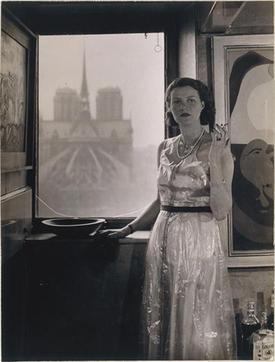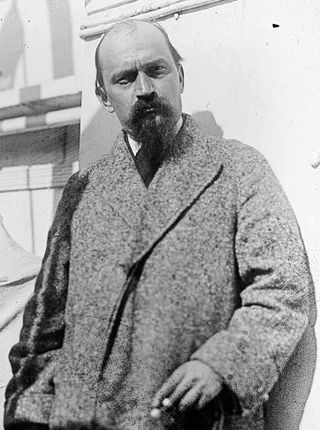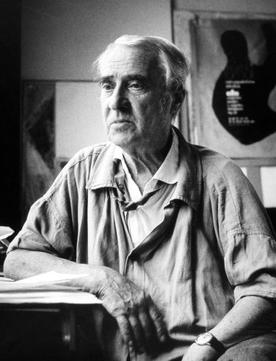Related Research Articles

Marguerite "Peggy" Guggenheim was an American art collector, bohemian, and socialite. Born to the wealthy New York City Guggenheim family, she was the daughter of Benjamin Guggenheim, who went down with the Titanic in 1912, and the niece of Solomon R. Guggenheim, who established the Solomon R. Guggenheim Foundation. Guggenheim collected art in Europe and America between 1938 and 1946. She exhibited this collection as she built it. In 1949, she settled in Venice, where she lived and exhibited her collection for the rest of her life. The Peggy Guggenheim Collection is a modern art museum on the Grand Canal in Venice, Italy, and is one of the most visited attractions in Venice.

Visual art of the United States or American art is visual art made in the United States or by U.S. artists. Before colonization, there were many flourishing traditions of Native American art, and where the Spanish colonized Spanish Colonial architecture and the accompanying styles in other media were quickly in place. Early colonial art on the East Coast initially relied on artists from Europe, with John White the earliest example. In the late 18th and early 19th centuries, artists primarily painted portraits, and some landscapes in a style based mainly on English painting. Furniture-makers imitating English styles and similar craftsmen were also established in the major cities, but in the English colonies, locally made pottery remained resolutely utilitarian until the 19th century, with fancy products imported.

Ivan Meštrović was a Croatian sculptor, architect, and writer. He was the most prominent modern Croatian sculptor and a leading artistic personality in contemporary Zagreb. He studied at Pavle Bilinić's Stone Workshop in Split and at the Academy of Fine Arts Vienna, where he was formed under the influence of the Secession. He traveled throughout Europe and studied the works of ancient and Renaissance masters, especially Michelangelo, and French sculptors Auguste Rodin, Antoine Bourdelle and Aristide Maillol. He was the initiator of the national-romantic group Medulić. During the First World War, he lived in emigration. After the war, he returned to Croatia and began a long and fruitful period of sculpture and pedagogical work. In 1942 he emigrated to Italy, in 1943 to Switzerland and in 1947 to the United States. He was a professor of sculpture at the Syracuse University and from 1955 at the University of Notre Dame in South Bend, Indiana.

Albert Gleizes was a French artist, theoretician, philosopher, a self-proclaimed founder of Cubism and an influence on the School of Paris. Albert Gleizes and Jean Metzinger wrote the first major treatise on Cubism, Du "Cubisme", 1912. Gleizes was a founding member of the Section d'Or group of artists. He was also a member of Der Sturm, and his many theoretical writings were originally most appreciated in Germany, where especially at the Bauhaus his ideas were given thoughtful consideration. Gleizes spent four crucial years in New York, and played an important role in making America aware of modern art. He was a member of the Society of Independent Artists, founder of the Ernest-Renan Association, and both a founder and participant in the Abbaye de Créteil. Gleizes exhibited regularly at Léonce Rosenberg's Galerie de l’Effort Moderne in Paris; he was also a founder, organizer and director of Abstraction-Création. From the mid-1920s to the late 1930s much of his energy went into writing, e.g., La Peinture et ses lois, Vers une conscience plastique: La Forme et l’histoire and Homocentrisme.

Gino Severini was an Italian painter and a leading member of the Futurist movement. For much of his life he divided his time between Paris and Rome. He was associated with neo-classicism and the "return to order" in the decade after the First World War. During his career he worked in a variety of media, including mosaic and fresco. He showed his work at major exhibitions, including the Rome Quadrennial, and won art prizes from major institutions.
Paul Jenkins was an American abstract expressionist painter.

The School of Paris refers to the French and émigré artists who worked in Paris in the first half of the 20th century.

Milena Pavlović-Barili was a Serbian painter and poet. She is the most notable female artist of Serbian modernism.

Julio González i Pellicer, born in Barcelona, was a Spanish sculptor and painter who developed the expressive use of iron as a medium for modern sculpture. He was from a lineage of metalsmith workers and artists. His grandfather was a goldsmith worker and his father, Concordio González, a metalsmith worker who taught him the techniques of metalsmith in his childhood years. His mother, Pilar Pellicer Fenés, came from a long line of artists.

Ammiel Alcalay is an American poet, scholar, critic, translator, and prose stylist. Born and raised in Boston, he is a first-generation American, son of Sephardic Jews from Serbia. His work often examines how poetry and politics affect the way we see ourselves and the way Americans think about the Middle East, with attention to methods of cultural recovery in the United States, the Middle East and Europe.
Albert Oehlen is a German artist. He lives and works in Bühler, Switzerland and Segovia, Spain.

Božidar Jakac was a Slovene Expressionist, Realist and Symbolist painter, printmaker, art teacher, photographer and filmmaker. He produced one of the most extensive oeuvres of pastels and oil paintings, drawings and, above all, prints in Slovenia. He was also one of the key organizers in the establishment of the Ljubljana Academy of Fine Arts and the International Biennal of Graphic Art in Ljubljana. Some of his work is on display in museums in Belgrade.
Edwin Curtis Moffat was a London-based American abstract photographer, painter and modernist interior designer.
Gary Schneider is a South African-born American photographer known for his portraiture and self-portraits. According to the John Simon Guggenheim Memorial Foundation, which awarded him a Guggenheim Fellowship in 2013, his "early work in painting, performance, and film remain integral to his explorations of portraiture. He strives to marry art and science, identity and obscurity, figuration and abstraction, the carnal and the spiritual."

Petar Omčikus, Sušak, 6 October 1926 – 26 April 2019) was a Serbian painter and member of the Serbian Academy of Sciences and Arts, who lived and worked in Paris, France.

Marino Tartaglia was a Croatian painter and art teacher, for many years a professor at the Academy of Fine Arts, Zagreb.
Milivoj Uzelac (1897–1977) was a painter influential in the Zagreb modern art scene of the 1920s and 30s. During the Zagreb Spring Salon of the 1920s, he participated with Vilko Gecan, Marijan Trepše and Vladimir Varlaj as the Group of Four. Uzelac spent much of his professional life in France, and is best known for his portraits and interior scenes with bohemian characters.

Man on a Balcony, is a large oil painting created in 1912 by the French artist, theorist and writer Albert Gleizes (1881–1953). The painting was exhibited in Paris at the Salon d'Automne of 1912. The Cubist contribution to the salon created a controversy in the French Parliament about the use of public funds to provide the venue for such 'barbaric art'. Gleizes was a founder of Cubism, and demonstrates the principles of the movement in this monumental painting with its projecting planes and fragmented lines. The large size of the painting reflects Gleizes's ambition to show it in the large annual salon exhibitions in Paris, where he was able with others of his entourage to bring Cubism to wider audiences.
Antonio Salemme was an Italian-born American sculptor and painter. His work included sculpted portraits of John F. Kennedy, Dwight D. Eisenhower, Albert Einstein, Paul Robeson, Ethel Waters, and classical nudes.

Portrait of an Army Doctor is an oil-on-canvas painting created during 1914–15 by the French artist, theorist and writer Albert Gleizes. Painted at the fortress city of Toul (Lorraine) while Gleizes served in the military during the First World War, the painting's abstract circular rhythms and intersecting aslant planes announce the beginning of the second synthetic phase of Cubism. The work represents Gleizes's commanding officer, Major Mayer-Simon Lambert (1870–1943), the regimental surgeon in charge of the military hospital at Toul. At least eight preparatory sketches, gouaches and watercolors of the work have survived, though Portrait of an Army Doctor is one of Gleizes's only major oil paintings of the period.
References
- ↑ Bryan Marquard (April 27, 2008). "Albert Alcalay; noted painter survived Holocaust". The Boston Globe.
- ↑ Albert Alcalay - John Simon Guggenheim Memorial Foundation Archived September 23, 2012, at the Wayback Machine
- 1 2 "Albert Alcalay, Prominent Contemporary Artist, Dies". The Vineyard Gazette - Martha's Vineyard News. Retrieved 2023-05-26.
- ↑ "The Martha's Vineyard Times - Art: Artist Alcalay celebrates grand 89th". Archived from the original on 2012-09-04. Retrieved 2011-07-28.
- ↑ Ken Gewertz (January 5, 2004). "'Albert Alcalay' provides rare look at rare man". The Harvard Gazette.
- ↑ "Albert Alcalay: Self Portraits on Vimeo" . Retrieved September 1, 2021.
- ↑ "'Albert Alcalay: Self Portraits' at the Fort Worth Modern". Art&Seek. 2008-11-13. Retrieved 2023-05-26.
- ↑ "Remembering Albert Alcalay". ArtsBoston.org. 2012-03-20. Archived from the original on 2012-03-20. Retrieved 2023-05-26.